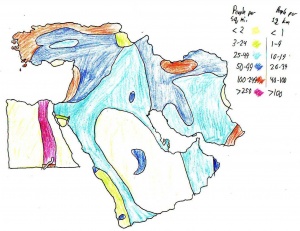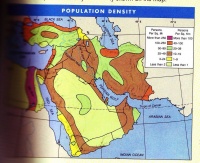World Cultures Portfolio/Middle East: Population Density
From ThePlaz.com
World Cultures Middle East
Intro/Basics - Africa - Middle East - South Asia - China - Japan - Korea - Latin America
World Cultures Daily Questions
Notebook
- Page 40 - Middle East Political Map, Geo Notes
- Page 41 - Portfolio Map Assignments Guidelines
- Page 42 - Middle East Water Tower Article, Page 2
- Page 43 - Arab Behavior Notes
- Page 44 - Why are we here? Fundamental Questions of Religion Circle Discussion Notes, Page 2, Page 3, Page 4, Page 5
- Page 45 - Western Religions Chart Page 1, Page 2, Christianity Basics, Page 2, Judaism Basics, Page 2, Islam Basics, Page 2, The Creation According to Islam
- Page 46 - Sharia's Reach, Page 2
- Page 47 - Middle East History Notes - Instructions, Page 2, Page 3, Page 4, Page 5, Page 6, Page 7
- Page 48 - Arab Isreal Map
- Page 49 - Arab Isreal Timeline
- Page 50 - Middle Eastern Groups
- Page 51 - A Failed Peace Chart
- Page 52 - Middle East Review Questions, Page 2
- Page 53 - Middle East Cause and Effect - OPEC, Iraq vs. Iran, Persian Gulf War 1, Persian Gulf War 2
- Page 54 - Red Textbook Photo Descriptions, Page 2, Terms Brainstorm, Page 2
- Page 55 - Metaphor Middle East Assessment Instructions
- Page 57 - Middle East Essay
Portfolio
Misc
- The Intertwined Path of Western Religions, Page 2
- Rough Sharia Notes, Page 2
- Ultra-Orthodox Basics, Page 2
Test/Quizzes
- I can't scan in my metaphor poster. I kinda missed the point of the metaphors going from concrete to abstract, so I won't post them. Sorry. I did the Prison of the Middle East.
The Middle East, a mosaic of cultures mixed together in a volatile world. Ready to blow up at a moment's notice, the Middle East is one of the world's most troubled spots. Vast stretches of desert exist where almost nothing can live. On the other hand, next door, the cradle of civilization exists with fertile valleys stretching as far as the eye can see. Then, in another few miles, comes the sea full of shipping and commerce.
???this para??? Fresh water is the lifeblood of all humans; without it, we would die. ???relavent?The Middle East is also where the East meets West. Ancient traders long crossed this land with caravans of precious goods to bring back to their homelands. mention rainfall?
Geographical diversity is one of the defining factors of the Middle East's character. From deserts to lush valleys, from mountains to oceans, the different sections of the Middle East define it. Vastly different geographies support vastly different population levels. Lush valleys support large amounts of crops which support a large population. Deserts, however, are devoid of life. They support nothing but a few creatures, if that. Thus the population of the Middle East is concentrated in a few select places, while vast stretches of desert sands lie practically empty.
One of the most fertile valleys in the Middle East, lies along the banks of the Nile River. The Nile River makes up the heart of Egypt, both modern and ancient. Until recently, the river flooded every year, depositing rich soil over the desert. This soil let crops be grown along the river, and could support a large population. This gave rise to one of the most recognized ancient civilizations on earth, Ancient Egypt. The rulers of Ancient Egypt managed to build huge pyramids with their large population. In present day, the Nile valley supports more then 250 people per square mile, the densest population in the Middle East. Nowadays the river has been dammed and modern means have replaced the floods, however the river is still the cradle of life for many people in Egypt.
But the problems with having such a large population is overcrowding. Cities especially suffer from the problem. Overcrowding breeds disease and lowers the living standards. The worst of these areas are the slums where the poorest of people live. Such peoples' lives are cut short by the filth around them caused by the high population density. However a large population also helps society become more productive. Thus a dense population represents a mixed blessing.
Another crowded section of the Middle East is the northern party of Turkey. This section in near Europe and the Black Sea. In fact, Turkey even extends into Europe near Instanbul. The climate here matches most of southern Europe's.
On the other hand, the desert in the middle of Saudi Arabia has almost no people living in it. Less then 2 people per square mile live there. However, in the middle the city of Riyadh exists because of seasonally flooding stream beds (Encarta). Riyadh actually means water bed in Arabic (Encarta). 50-99 people per square mile live in the middle of the desert which has become a center of commerce (Encatra, Textbook Map). The definition of a desert is a place which receives little rain. Water of course is required for people to live. Without water, no life can be supported.
Water, the life blood of the Middle East, controls the population. Rainfall is greatest around Turkey, which reaches about 40 inches per year (Encarta Annual Rainfall Map). It is especially heavy around the Black Sea, to the north of Turkey (Encarta Annual Rainfall Map). Also rainfall is heavy to the south and southeast of Turkey, extending partly into the northern part of Iran.
The section of the Middle East which included Israel and the occupied Palestinian territories is also very crowded. The region has always been a hot spot because it is near the Mediterranean Sea. Much history has been built into this region for all of the large western religions. Many people live in the region and the farming is quite good (give book example) One of the problems with the region, however is that as people, Palestinians mostly, are being forced out of their lands and they have nowhere to go. As one moves into Saudi Arabia, the land quickly becomes uninhabitable desert. As with everywhere else on Earth, there's only a certain amount of livable land available. This forces the population density to increase, and again, causes a decline in the overall standards of living. This problem is magnified because of the cultural and religious differences which occur in the region and separates the groups even further.
Section under lake in Iran (Caspian Sea)
Near seas
However, these rules are changing. New desalination technology is letting more people live in areas which receive less fresh water. However, these methods are still expensive. But even newer methods reduce the cost of desalination. With an almost endless supply of salt water, these new technologies can change deserts into driving ranges.
In fact, if one looks at the map of annual precipitation in the Middle East, one would notice that the maps almost align. The darkest regions on the rainfall map (the areas which get the most rain) for the most part have large populations. An example, again, would be Turkey. On the other hand, not many live in the dry deserts of lower Oman. However, there are some discrepancies. Egypt is receives almost no rain, but still has the largest population in the Middle East because the water flows down the Nile from the wetter regions in the north. Also, the sections near water, such as the cost of the Arabian Peninsula support large populations while receiving little rain. This may be because the large sea supports the people using desalination plants. ?other reason? - has to be
The Encarta ecological map matches almost exactly with the population density map. The more green the region on the ecological map, the more temperate and wet the region is. It also happens to be the more people are able to live in that region. For example, the northern part of Turkey, as well as the section of Iran directly under the Caspian Sea are temperate wet forests population levels. The eastern section of Turkey is Mediterranean woodland. 50-99 people per square mile call it their home. This is less then other parts of Turkey, but substantial for the Middle East (add lower sections)
The climate map, however, does not match up real well except in Turkey, where the climate is different from the hot deserts of the Middle East. Somehow the hot and arid conditions do not seem to affect the people living in the Middle East.
closing
cite map + parenthitcals for map
- Encarta Map Middle East Ecological
- Encarta Map Middle East Annual Precipitation
- Encarta Map Middle East Climate
- blue textbook
Africa: HDI Graph Reflections - Decolonization Report
Middle East: Population Density Report - Essay: A Peaceful Vacation
South Asia: Rainfall Report - South Asia Comparisons Graph - Postcards
China: Sphere of Influences Report - Mao Button Journal
Japan: Natural Resources Report - Japanese Violence Journal
Korea: Physical Map Report
Latin America: Landforms Report
Worldwide: T-Shirt Trade Report




